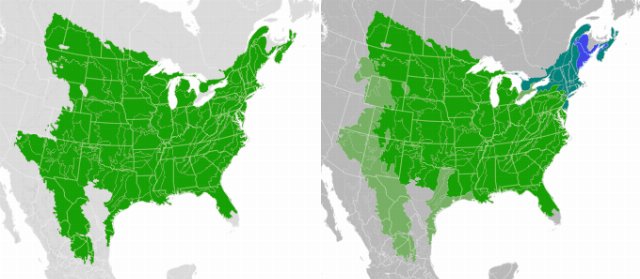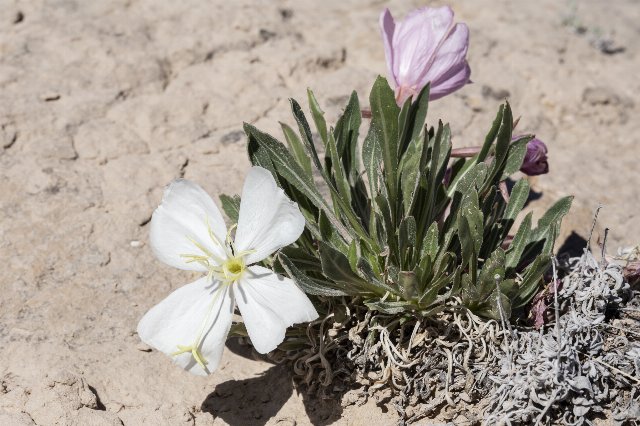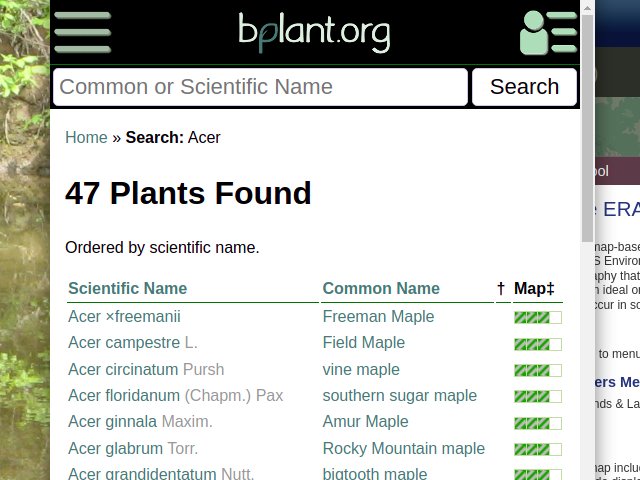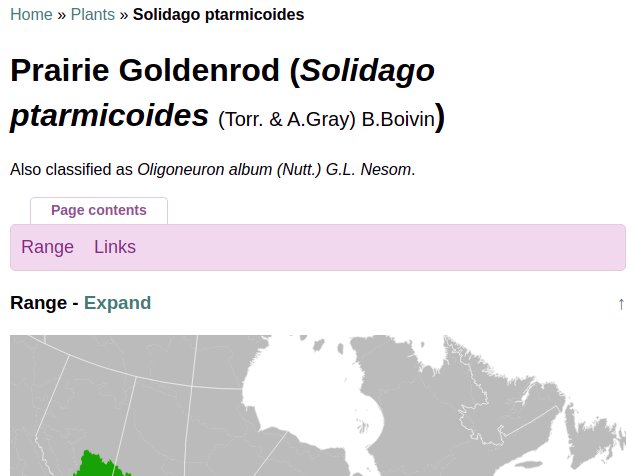Progress Updates on Range Maps and More
February 10th, 2022 by Alex Zorach
This past July, we announced the completion and publishing of 15,232 new range maps which brought numerous improvements on the previous 5,660 range maps we had published (based on the Ecoregional Revegetation Application or ERA.) At that point in time, we still had well over 1,200 of the old ERA maps that had numerous serious problems, including over-estimating plant ranges around the edges, and marking many species uniformly native that were not actually native in all parts of the continent. See our August 2019 post for a full explanation of the limitations of the ERA maps. Here is the old range map for smooth oxeye (Heliopsis helianthoides) on the left, and the new one on the right. The new map offers multiple improvements, noting how this species is expanding its range (blue) into New England, where it is not truly native. The edges of the range have been reduced, particularly in the west where they were overestimated on the original maps; pale green denotes where the plant may or may not be found. The background color has also been darkened to make state boundaries clearer.
Here is the old range map for smooth oxeye (Heliopsis helianthoides) on the left, and the new one on the right. The new map offers multiple improvements, noting how this species is expanding its range (blue) into New England, where it is not truly native. The edges of the range have been reduced, particularly in the west where they were overestimated on the original maps; pale green denotes where the plant may or may not be found. The background color has also been darkened to make state boundaries clearer.Since then, we have had numerous breakthroughs in the construction of range maps, and in other related aspects of our site. We developed frameworks for matching records in different databases and websites in the cases where the same taxon of plant (which could be a species, subspecies, variety, or other taxon) is referred to by different names. These improvements are an outgrowth of our interlinking with different plant databases that began in late 2020, and, besides facilitating range map construction, have also resulted in more thorough interlinking so that our plant pages now link to more external pages. We have also merged a few duplicate records and cleaned up various inconsistencies.
We have now published 16,277 of the improved maps. Of these, 307 have been verified to be accurate to level 3 ecoregions in all of North America (including Canada, Mexico, and Alaska.) The remainder of the maps are verified within the continental US only. Only 123 of the problematic ERA maps remain, and we are working rapidly to replace these. In the near future, we may simply take down the remaining ERA maps so as to reduce the amount of misinformation on our site. We have also been expanding the numbers of total maps, covering both native and non-native species that were not included in the ERA.
Sorting Out Reclassified Plant Taxa
One of the barriers to building our range maps, and to our research in general, has been the fact that numerous plant taxa have been reclassified, sometimes multiple times and in complex ways. What this means is that when we consult different sources, these sources do not always refer to the same plant populations by the same names. Not only are the same taxa referred to by different names in different sources, but different sources also group different populations in different ways, so that there is not always a clean one-to-one correspondence between the list of species or subspecies considered in one source, and those in another. The Oenothera genus, evening-primroses, and related genera, have experienced a lot of taxonomic flux. Pictured here is Oenothera caespitosa Nutt., which is sometimes spelled Oenothera cespitosa. However, the proposed variety Oenothera cespitosa var. psammophila (A.Nelson & J.F.Macbr.) Munz. is now considered by most authorities to be its own species, Oenothera psammophila. Many taxa have had multiple varieties or subspecies spun off into separate species in such a manner; sometimes they are treated as new species, other times merged into existing species. The relationships between different classification systems can thus become highly complex. Public Domain photo by Patrick Alexander, Source.
The Oenothera genus, evening-primroses, and related genera, have experienced a lot of taxonomic flux. Pictured here is Oenothera caespitosa Nutt., which is sometimes spelled Oenothera cespitosa. However, the proposed variety Oenothera cespitosa var. psammophila (A.Nelson & J.F.Macbr.) Munz. is now considered by most authorities to be its own species, Oenothera psammophila. Many taxa have had multiple varieties or subspecies spun off into separate species in such a manner; sometimes they are treated as new species, other times merged into existing species. The relationships between different classification systems can thus become highly complex. Public Domain photo by Patrick Alexander, Source.In order to resolve these issues, we have begun adding additional features to our site. Many of these features are public-facing and will help you to know what is going on in the case of taxa that have been reclassified.
Authorities for Scientific Names
In keeping with common practice in plant taxonomy (and science in general), we now list an abbreviated authority next to the scientific name of each plant. These authorities represent the author that published the description of the type specimen for that species and named it, and in some cases, the author(s) that renamed them, in the cases that the type specimen was reclassified. You will see these authorities in searches, written in lighter gray text to de-emphasize them, as well as on the page for each plant. Authorities are now listed after scientific names both during searches and on plant articles. Pictured here is the search for "Acer", the genus of maples.
Authorities are now listed after scientific names both during searches and on plant articles. Pictured here is the search for "Acer", the genus of maples.Although in most cases referencing such authorities is not necessary, and in others, it is not sufficient for resolving ambiguity, there are some cases where checking the authorities can help to know what a particular name is referring to. Because it is "better than nothing", we have included this extra information in order to make our site more useful when referring to groups of plants that have been reclassified.
"Synonyms" of Scientific Names
As we record information about taxa that have been reclassified, we add scientific names to our site that are listed as "synonyms", typically in authorities like Plants of The World Online (POWO) and the closely-related International Plant Name Index (IPNI), and Tropicos. Thus, if you type in a scientific name that now points to a different species, the species it points to will show up in your search. For example, if you type in "Oligoneuron album" in the search, it will return a record for "Solidago ptarmicoides (Torr. & A.Gray) B.Boivin", and on the page for that plant it will list "Oligoneuron album (Nutt.) G.L. Nesom." under "Also classified as...": This screenshot shows the page for a plant, prairie goldenrod (Solidago ptarmicoides), that has been reclassified, with the old synomym listed. Also note the authority both after the (new) accepted name and after the synonym.
This screenshot shows the page for a plant, prairie goldenrod (Solidago ptarmicoides), that has been reclassified, with the old synomym listed. Also note the authority both after the (new) accepted name and after the synonym.These "synonyms" do not always represent one-to-one relationships. In taxonomy, what is considered a "synonym" is not a true synonym in the common sense of the word, and as such, it is perhaps a poor and misleading choice of technical language. Rather, a taxonomic authority will group together different scientific name + author combinations, which refer to different type specimens that the authority considers to be part of the same taxon. The name for the oldest type specimen is accepted as the name for the taxon, and others are listed as "synonyms".
However, other authorities may group taxa differently, and in general, authorities do not agree about which names are "synonyms" of each other. Even when they do agree, they may have different criteria that they use to classify individuals or populations other than the type specimens. Therefore the different names listed as "synonyms" do not necessarily refer to the same populations of plants when you see them written in external sources. This lack of correspondence can be confusing and can severely hinder one's ability to synthesize information from different sources.
We have not exhaustively listed these "synonyms" of each plant. For the time being, we have focused on plants where there are disagreements or inconsistencies between the sources we most frequently cite and link to, and have tried to list most names that are in widespread use. If you want a more comprehensive list of plant synonyms, we recommend looking at POWO, ITIS, or Tropicos. However, we warn you that these sites do not provide any clarification of relationships, and thus may have limited usefulness for resolving some of the tougher questions.
Future Plans for Handling "Synonyms"
Because the naming authority alone is not sufficient to unambiguously define what a name is referring to, in the long-run, we are working to implement a more rigorous system inspired by the notation Alan Weakley uses in his Flora of the Southeastern United States. We also hope to implement a system such as that proposed in this 2005 paper to facilitate data integration. These systems are currently in their early stages; we will write about them in a future post. We hope, however, that when they are implemented, they will greatly clarify the relationships between the different scientific names in the cases of reclassified and/or disputed taxa.Donations & Financial Statement
Our 2021 financial statement is up; you can find it on our finances page, which you can always find in the footer of our site.We are pleased to announce that in 2021, both our number of donors and our total amount of donations more than doubled. In addition, our percentage of donations spent on payment processing fees decreased slightly.
However, we failed to meet our $5000 end-of-year fundraising goal. For this reason, we are leaving our fundraising banner up on the header of our site, and will leave it up until this goal is met. Once it is met, the banner will not reappear until November. Thank you to everyone who has donated! We actually have received a flurry of donations in the new year, and are much closer to meeting our goal than we were at the year's end.
Plant Lists Are Coming Soon!
We have a number of exciting developments that we hope to complete within the next few months. One of the biggest of them is the publishing of plant lists for each (level 3) ecoregion in the continental U.S. This will allow users to generate lists of locally-native plants.In order to generate accurate lists, we need to ensure that our data on these regions is reliable. The integrity of this data is currently the limiting factor preventing us from generating these lists. As soon as the remainder of the ERA maps are either replaced with our improved maps, or retired, it will likely be a short period of time, possibly a few weeks, before we publish these lists.
As a limiting factor in building the remaining maps is the resolving of difficult taxonomic relationships, we may end up building, at least partially, the tools discussed above to clarify the complex relationships between taxonomic "synonyms", as a stepping stone on our way towards the publishing of plant lists. And as we do this, it will become easier to link more of our plant articles to more external resources. So you can expect to see a lot of different incremental improvements to our site happening in the coming months, and it is possible that you may see some of the more "advanced" features such as clarification of relationships between different names for the same taxon, before plant lists are released!
Enjoy!
Archive of All Blogs
The Bias Against Tall Plants, November 11th, 2025
A Focus on Goldenrods (Solidago sp.), July 23rd, 2025
Disturbance and its Role in Plant Habitat Preferences, May 29th, 2025
What "Native" or "Introduced" Mean: Myths and Misconceptions, March 11th, 2025
Smarter & More Informative Search Results, January 13th, 2025
The Effect of the 2024 US Election on Plant Biodiversity and bplant.org, October 30th, 2024
The Problems With Nursery-Bought Plants, And The Solutions, October 8th, 2024
More Databases Linked & Search Improvements for Scientific Names, July 9th, 2024
Choosing The Best Common Names For Plants: Challenges & Solutions, April 19th, 2024
Range Map & Taxonomic Update Progress, January 31st, 2024
Giving Thanks To Everyone We Rely On, November 22nd, 2023
Thinking More Deeply About Habitat, April 5th, 2023
2022 Year-End Summary: Successes & New Goals, February 15th, 2023
New Databases Linked: Flora of North America & NatureServe Explorer, November 11th, 2022
All Range Maps 2nd Generation, Taxonomic Updates, & Fundraising Goal Met!, September 29th, 2022
More Range Map Improvements, POWO Interlinking, And Notes Fields, June 7th, 2022
Ecoregion-Based Plant Lists and Search, March 30th, 2022
Progress Updates on Range Maps and More, February 10th, 2022
The Vision for bplant.org, December 9th, 2021
New Server: Software & Hardware, August 30th, 2021
More & Improved Plant Range Maps, July 19th, 2021
A Control Section for Invasive Plants, April 15th, 2021
Progress Bars & State Ecoregion Legends, March 11th, 2021
Our 2020 Achievements, February 9th, 2021
Interlinking Databases for Plant Research, November 11th, 2020
A New Homepage, Highlighting Our Articles, July 29th, 2020
A False Recovery, But North Carolina's Ecoregions are Complete!, June 9th, 2020
We're Back After COVID-19 Setbacks, April 3rd, 2020
Help Us Find Ecoregion Photos, February 27th, 2020
What We Achieved in 2019, December 30th, 2019
Plant Comparison and ID Guides, October 30th, 2019
We Are Now Accepting Donations, October 14th, 2019
US State Ecoregion Maps, New Footer, Ecoregion Article Progress, and References, September 19th, 2019
Tentative Range Maps of Native Plants, August 12th, 2019
Ecoregion Locator and Interactive Maps, July 10th, 2019
Using Ecoregions Over Political Boundaries, May 13th, 2019
How We Handle Wild vs Cultivated Plants, April 16th, 2019
A Blog To Keep People Updated On Our Progress, April 8th, 2019
Sign Up
Want to get notified of our progress? Sign up for the bplant.org interest list!


